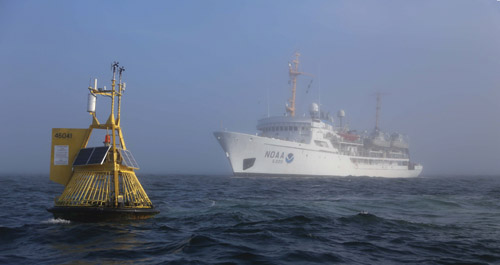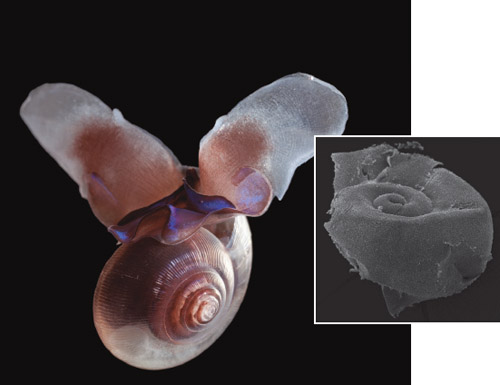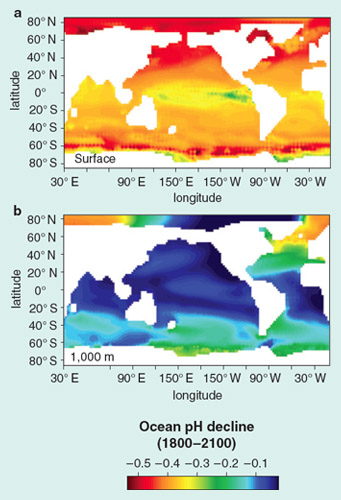Ocean Acidification: The Other Climate Change Issue
By Ashanti Johnson, Natasha Denise White
Carbon dioxide from the atmosphere reacts with coastal water to increase the acidity of the ocean, a trend that threatens many marine ecosystems.
Carbon dioxide from the atmosphere reacts with coastal water to increase the acidity of the ocean, a trend that threatens many marine ecosystems.

DOI: 10.1511/2014.106.60
Within Earth’s vast oceans exists a diverse population of beautiful creatures that depend on a delicate balance of chemistry to remain viable. The tiniest animals are often the most important and underestimated species in any environment; they also are among the most vulnerable.

Photograph courtesy of ENS Gavin Chensue, NOAA Corps.
In the frigid waters of the Southern Ocean, off the coast of Antarctica, one such creature is the pteropod, Limacina helicina antarctica. These pea-sized marine snails, popularly known as sea butterflies because they appear to be using two “wings” when they swim, serve as a major food source for commercial fishes such as pink salmon. Yet this crucial resource is on the wane, as increasing levels of acid in the ocean threaten to dissolve its aragonite shell and impair its normal development.
More than 200 years ago, people developed a variety of machines to accomplish tasks traditionally completed by hand. These great advances in technology, however, have come at a steep price: the industrial and agricultural activities that drive our global economy have added significantly to the levels of carbon dioxide in the atmosphere. Most carbon dioxide remains in the air, but as much as 25 percent is absorbed by the world’s oceans, according to the National Oceanic and Atmospheric Administration (NOAA). Once in the water column, carbon dioxide (CO2) reacts with water (H2O) to yield carbonic acid, which releases hydrogen ions (H+), effectively increasing acidity.
Since the start of the Industrial Revolution, the pH level of the world’s oceans has dropped by 0.1 unit, which amounts to a 30-percent increase in acidity. Estimates based on business-as-usual scenarios from the Intergovernmental Panel on Climate Change (IPCC) suggest that if current trends persist, oceanic pH could drop by another 0.5 unit by the end of this century. That is a huge change: a 150-percent increase in acidity. Such an alteration in the marine environment could have devastating results both for ocean organisms and for the people who depend on them.
Metals occur naturally in many coastal and estuarine environments and are essential for the growth and survival of microorganisms that live by means of photosynthesis. A balance of trace metals, such as iron, nickel, copper, zinc, and cadmium, is crucial. If trace-metal concentrations fall too low, photosynthesis falters; if they rise too high, the excess of metal may prove toxic. For any given substance (metal, nutrient, or even a contaminant), the amount that may be readily metabolized is known as bioavailable.
The potential of ocean acidification to influence the bioavailability of metals comes down to basic chemistry. Increasing influxes of CO2 cause a decrease in pH, which results in an increase in H+ and thus a decrease in hydroxide and carbonate ions in most surface waters. Normally, both hydroxide and carbonate form strong complexes with divalent and trivalent metals, effectively sequestering those compounds from uptake by photosynthetic organisms; under acidified conditions, however, hydroxide and carbonate remain as free metals that are bioavailable.
Recent environmental models suggest that hydroxide and carbonate ions will decrease consistently—as much as 82 and 77 percent, respectively—by the end of the century. Such a decrease is expected to change the speciation of a number of metal ions. Most organic macromolecules in seawater are negatively charged; therefore, as a result of lowered pH, the surface of the organic macromolecules is less available to form complexes with metals.
A number of studies have predicted that ocean acidification might exacerbate the potential effects of other anthropogenic stressors, thereby raising the bioavailability of environmental contaminants, particularly that of water-borne metals. Acidification also modifies the interactions between marine organisms and metals. Ambient trace-metal concentrations in the open ocean are low; marine organisms have evolved efficient mechanisms to compensate for this, many of which are yet to be characterized. Not surprisingly, small increases in the concentration of normally scarce metals often prove toxic.
Most scientists believed the carbon storage capacity of the oceans to be nearly limitless. They were wrong.
Individual metal species have different fates and cause varied impacts, depending on their function in the environment. For example, should ocean acidification increase the available concentration of free ionic copper, productivity in photosynthetic organisms may decrease. The resulting increase in free ionic copper in the environment can cause physiological damage to some aquatic species. Copper affects the activation of olfactory receptor neurons by competing with natural odorants for binding sites; such an effect has been shown to impair the sense of smell in juvenile coho salmon (Oncorhynchus kisutch). These fish depend on olfaction to find food, avoid predators, and migrate. According to one study, even low levels of copper produced a physiological stress response, characterized by hyperactivity, elevated blood levels of the stress hormone cortisol, and an increase in the synthesis of metallothionein, a metal-detoxifying protein.
On the other hand, antagonistic (decreased) toxicities have been observed between carbon dioxide and free ionic copper in a small coastal crustacean, Amphiascoides atopus. Metal toxicity was likely antagonistic because of the presence of increasing H+ and the competition for binding sites between CO2 and copper for H+. Alternatively, the observed antagonistic effect could be due to the animal’s suppressed metabolism, which would reduce its rate of metal transport. If acidified conditions should cause the concentration of dissolved iron to rise, this may stimulate photosynthesis, giving rise to a negative-feedback mechanism. This mechanism has a potential positive effect: Ocean acidification may actually make more iron bioavailable, thanks to both the increased fractionation of dissolved iron and elevated iron (Fe2+) concentrations in coastal systems.
The effects of ocean acidification fall not just on certain species or particular regions, but throughout the food webs of the globe. According to the NOAA Ocean and Great Lakes Acidification Research Plan, changes in ocean chemistry probably exert several indirect effects: shifting predator–prey interactions, increasing the prevalence of invasive species, modifying the distribution of pathogens, or altering the physical structure of ecosystems. Naturally, some organisms are expected to experience greater effects than others. Among those most likely to take a hit are the calcifying organisms, such as corals, clams, scallops, oysters, and other shellfish. Conversely, some photosynthetic zooxanthellae (the symbionts that live on coral and provide its nutrition) or shallow near-shore seagrasses may be individually stimulated by an increase in carbon dioxide. Their stimulation is expected to change the dynamics of the ecosystem by disrupting nutritional transfer from zooxanthellae to corals and by interfering with the efficient use of carbon by thriving seagrasses, leading to overpopulation.
Initial studies focused on the negative effects of decreased calcium carbonate (CaCO3) saturation and on the inability of calcifying organisms to produce protective shells; more recent studies show that acidification may also take a toll on species growth, behavior, and survival. Noncalcareous species such as fish have shown impaired development and decreased olfactory ability, as well as some evidence for changes in body composition and a decrease in growth rate. Bacterioplankton may also be affected by acidification, exhibiting longer bloom times, increased growth rate, and increases in nitrogen fixation. A secondary impact for humans and wildlife may arise from the extended bloom of certain bacterioplankton, which can secrete substances that are toxic to some humans and wildlife.
When carbonate concentrations decrease in the oceans and bivalves become less able to extract it effectively, they form thinner shells that make them more susceptible to predators. A computer simulation of future ocean conditions showed that three ecologically and commercially important bivalve species—the hard clam (Mercenaria mercenaria), the bay scallop (Argopecten irradians), and the Eastern oyster (Crassostrea virginica)—would suffer delayed metamorphosis and reduced growth in response to lower levels of carbonate. The impaired ability of each species to form a calcified skeleton appeared likely to translate into prolonged predation on the more vulnerable species and a decrease in the survival rate of their larvae.

David Liittschwager/National Geographic Society/Corbis; Inset image courtesy of NOAA.
Within the marine environment, the sea butterfly is an indicator species currently threatened by the pH changes taking place both in deep water and near the ocean surface. Among the first ecosystems to be identified as vulnerable, of course, were the coral reefs. In addition to the vulnerability of the coral species themselves, coralline algae, calcareous benthic foraminifera, and other reef-building species may be affected. One review estimates that by the middle of the century, corals and calcifying macroalgae will calcify 10 to 50 percent less than before the Industrial Revolution. This steep decrease will take a toll not only on the coral’s functioning but also on other ecosystem dynamics (such as the interaction between coral and its symbionts) and on the architectural complexity of the reefs the corals construct. In one study, researchers postulate that the loss of architectural complexity will decrease habitat diversity, which in turn will drive down biodiversity. This decrease, together with the loss of coral reef species through bleaching, disease, and overexploitation, threatens the persistence of coral reef and fish communities and of the sustenance fishers who depend on them.
If ocean acidification continues as expected, can evolution offer a key to the health of marine organisms? Not all species can adapt rapidly to changing environments; those that have this capability, however, show that rapid evolution can alter responses to environmental change, ultimately affecting the likelihood that a population will persist. During the Paleocene-Eocene thermal maximum, a brief warming spell that occurred about 55 million years ago, animals that evolved lighter skeletons were able to remain in areas where calcium carbonate is relatively difficult to obtain.
The capacity for organisms to undergo rapid evolution is likely dependent on their existing genetic variation. For example, the purple sea urchin (Strongylocentrotus purpuratus) that inhabits the Pacific Coast is known for its ability to adapt quickly to acidified conditions. In its larval development and morphology, the purple sea urchin shows little response to lower acidity; nevertheless, in the genome of this organism, researchers have observed substantial allelic change in a number of functional classes of proteins involving hundreds of loci. For millions of years, the upwelling of waters rich in carbon dioxide from the ocean’s depths have exposed these organisms to significant highs and lows of acidity; this is the probable explanation for their chemical tolerance.
The major culprit behind ocean acidification has been atmospheric carbon dioxide, although other factors have also contributed to the problem, especially in coastal regions. Freshwater tributaries, pollutants from surface runoff, and soil erosion can acidify coastal waters at significantly higher rates than carbon dioxide alone. In 2007, researchers at the Woods Hole Oceanographic Institution (WHOI) surveyed the waters of the eastern United States and the Gulf of Mexico to measure levels of CO2 and other forms of oceanic carbon. When they compared these to the water’s total alkalinity, the study revealed that the East Coast was considerably more sensitive to acidified conditions than was the Gulf of Mexico.

Adapted from Ilyina, T., R. E. Zeebe, and P. G. Brewer, Nature Geoscience 3:18.
Regular inputs from the Mississippi River, surface runoff, and other human impacts all affect the pH of the Gulf of Mexico. These factors, coupled with the high ratio of alkalinity to dissolved inorganic carbon, help to explain why the Gulf of Mexico has so far resisted acidification. As the WHOI researchers traveled north, they noted decreases in the ratio of alkalinity to dissolved inorganic carbon, indicating that those regions, specifically the coastline north of Georgia, would be more vulnerable if carbon dioxide levels were to increase there.
Subsistence fisheries, too, are likely to be harmed. According to a Blue Ribbon Panel Report from the state of Washington, ocean acidification is already demonstrating an impact on oyster shell growth and reproduction. Planning and resource management hold some promise for addressing the threat of acidification, but the unpredictable time scale and the variable nature of the effects remain stubborn challenges.
Anthropogenic inputs of carbon dioxide to the atmosphere are likely to continue causing environmental damage for the foreseeable future—and not only in the air we breathe. The oceans play a significant role in sequestering carbon from the atmosphere. Indeed, they work so well as a carbon sink that until recently most scientists believed the carbon storage capacity of the oceans to be nearly limitless, thereby serving as a negative feedback mechanism for atmospheric carbon inputs. These initial hypotheses were wrong. We are now witnessing changes in ocean chemistry that will affect inorganic and organic metal speciation and could even increase the bioavailability of toxic metals. Clearly, we cannot continue to rely on the oceans to buffer the effects of our pollution indefinitely.

Illustration by Tom Dunne.
The effects of ocean acidification are far from uniform. Coastal regions are likely to be disproportionately affected by compounding carbon input sources such as runoff from agriculture, industry, and urban populations. Moreover, certain marine species are vulnerable to acidification whereas others are relatively resilient. Using current legislation—in particular, the U.S. Clean Water Act and the Clean Air Act—to enforce more stringent emissions standards may offset some of the harm caused by the rising acidity of the oceans. Confronting this threat will require broader public awareness, clear interpretation of data, and reasoned predictions. Ultimately, more sustainable practices, including reducing anthropogenic emissions of carbon dioxide to the atmosphere, must be adopted globally to offset the harm already done and to ensure that marine ecosystems remain viable.
Click "American Scientist" to access home page
American Scientist Comments and Discussion
To discuss our articles or comment on them, please share them and tag American Scientist on social media platforms. Here are links to our profiles on Twitter, Facebook, and LinkedIn.
If we re-share your post, we will moderate comments/discussion following our comments policy.